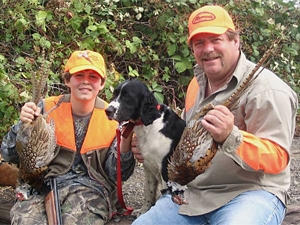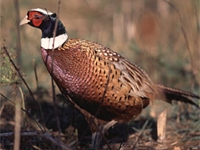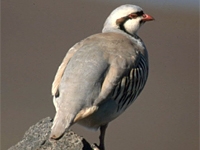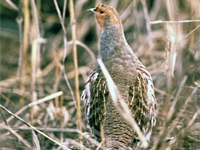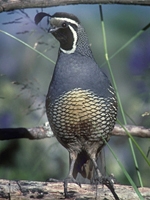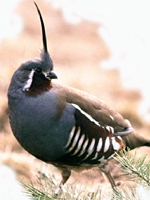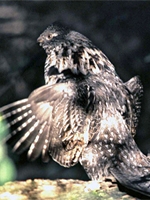
How to hunt upland game birds
Oregon offers some of the best upland game bird hunting in the West. The state’s diverse habitats support nine species of upland game birds— pheasants, chukar, Hungarian partridge, valley (California) quail, mountain quail, ruffed grouse, blue grouse, sage-grouse and wild turkey. There are upland hunting opportunities in every corner of the state, and one upland bird season or another is open continuously from September 1 through January 31. Throw in a six-week spring turkey season and you can hunt upland game birds in Oregon for more than half of the year! Also, since many of the species share similar habitat preferences, you can hunt for several species at a time.
Photo by Dave Budeau

License requirements
A valid hunting license, upland game bird validation, and HIP (Harvest Information Program) validation are needed to hunt the nine types of upland birds in Oregon, and these can be purchased anytime prior to hunting. Exceptions:
- Sage-grouse hunters need an additional permit because these hunting opportunities are limited entry. *Apply July 1
- Turkey hunters must purchase a turkey tag.
- ODFW stocks four wildlife areas in western Oregon with pheasants to create additional hunting opportunity; these hunts require a special “fee pheasant” tag.
When to hunt
See the current Oregon Game Bird Regulations for season dates, but generally at least one upland game bird season will be open beginning in September and runs through the end of January. Turkey hunters enjoy an additional six-week spring season (mid-April through the end of May).
Hunting techniques
Similar methods are used to hunt pheasant, grouse, partridge and quail. Some of these hunting techniques are described below. Though turkeys are an upland game bird, they aren’t emphasized here because turkey hunters often use different strategies; see ODFW’s turkey hunting article for more information. Sage-grouse hunting is also not covered because ODFW offers a limited number of permits in designated areas.
Upland game bird hunting is mostly about walking through areas that are likely to hold birds. Knowing food and habitat preferences for the particular upland bird you are hunting will help you find promising hunting locations; see below for that information. By far the best way to learn about upland game bird hunting is to just go—ideally with someone experienced, so if invited on a hunt don’t pass it up. Another option is to sign up for one of the Upland Game Bird workshops and events. Learn the basic fundamentals from experienced hunters and apply that knowledge in the field. The more you go, the more successful you'll be, by recognizing the type of habitat the birds frequent and the signs (tracks, scat) of upland game birds.
Though not a necessity, your hunting experience can be improved with a good bird dog. Dogs not only help you find birds that would rather hide than flush, but can also help find downed birds. Generally speaking, there are two types of upland bird dogs: pointers and flushers. Pointing breeds include setters, pointers, Brittany, German short-hairs, and many others. They have been bred to freeze upon bird scent, giving the hunter extra time to approach the bird and prepare for the shot. Flushing dogs (retrievers and spaniels) chase game birds until they flush, and many will instinctively retrieve downed game.
Where to hunt
Check out ODFW’s Hunting Access Map online to find out where you can go upland bird hunting. Many private lands that boast good upland bird populations are open to public hunting access, thanks to special ODFW programs. State-managed wildlife areas, federal wildlife refuges, and BLM and Forest Service lands are also good places to go. Remember, you are responsible for knowing boundaries and regulations for your hunting area, and you must get permission to hunt on private lands. Most wildlife areas and refuges require that hunters use and possess only federally-approved, nontoxic shot.
Pheasants
Some of Oregon’s best pheasant hunting is in eastern Oregon agricultural areas, like the Columbia Basin and farmlands along the lower Malheur River and Owyhee River drainages. Look in idle fields and fence rows near grain production; pheasants will also graze on wild seeds from weeds. These birds will run and sometimes sneak back around you; to find them keep your eyes open, looking around as you walk. Remember that ODFW plants pheasants at four western Oregon wildlife areas during the fall; see the current Oregon Game Bird Regulations for details.
Chukar
Chukar are one of Oregon’s most challenging birds to hunt due to the rocky, rugged habitat they prefer and their ability to run uphill (and fly downhill) very quickly. Good chukar hunting areas include the lower Deschutes and John Day rivers, the Snake River and several of its tributaries, Malheur and Owyhee River drainages, and mountain ranges including Steens, Hart and Trout Creek mountains in southeast Oregon. Chukar are usually associated with the weedy annual grass known as cheatgrass—they consume its seed, and graze on new green growth. The best way to get within range of a chukar is to approach from above or on a contour. Look near water sources in the early season and when conditions are dry. Good boots, a water bottle, sufficient food and shells to stay afield all day are necessary to be successful at chukar hunting. Binoculars are also helpful.
Hungarian partridge
Huns are usually hunted incidentally to pheasants or chukars. Look for them in bunchgrass and sagebrush foothills adjacent to wheat and other farmlands. Like chukar, huns are swift and challenging to hunt. In eastern Oregon the best partridge populations are in the Columbia and Snake River Basin counties.
Valley (California) quail
One of Oregon’s most widely distributed game birds, valley quail are very adaptable and can be found from agricultural or urban areas to riparian habitats located miles from humans. They need a combination of brushy, escape cover, adequate roosting areas (off the ground) and open areas for feeding. You'll seldom find them far from water. To find valley quail, listen for their distinctive call which seems to say “Chicago." They are covey-loving birds and wintering groups may number over 100. Because they live in brushy environments, a good dog is an especially useful companion for hunting valley quail.
Mountain quail
Mountain quail are challenging to hunt due to the brushy and often steep nature of their habitat, and their tendency to run in heavy cover. Larger than valley quail, they thrive in the natural brushlands of southwestern Oregon, with their numbers gradually decreasing as one moves north and east. In northwest Oregon, look for them in disturbed (e.g. logged or burned) areas. Mountain quail have declined east of the Cascades and there are fewer areas open to hunting than in the west. If you do hunt east of the Cascades, look for mountain quail in brushy and diverse riparian habitat. Since coveys may be widely separated, a popular mountain quail hunting method involves driving logging roads until you see birds and then hunting on foot. Once you find a covey, it will probably not be far away on future visits.
Ruffed grouse
The ruffed grouse is a bird of the edge, so look in edges of meadows, clearcuts, and where brushy growth meets timber. In September, when most ruffed grouse hunting takes place in Oregon, ruffs are generally pretty close to water or sources of food like bearberry and huckleberry. In eastern Oregon, look along creek bottoms which are heavily grown with dogwood, alder and aspen, and where there is a good assortment of berries (currant, gooseberry, snowberry, elderberry) and fir trees adjacent to the creek bottoms. As one gets lower on the stream and fir gives way to pine, there will usually be fewer grouse. In western Oregon it is harder to locate good areas because there is so much good habitat, and birds are seldom concentrated in one area. Generally, streams are worth investigating as are edges of clearcuts at lower elevations and other places that just look “birdy.” Ruffed grouse are also attracted to Oregon crabapple, a native tree found west of the Cascades. However, like gold, ruffed grouse are where you find them, and avid grouse hunters are like anglers and mushroom pickers—not likely to tell you their favorite spots. Keep at it and you’ll find your own.
Blue grouse
Blue grouse occupy the coniferous forests of western Oregon, the eastern slopes of the Cascades, the Blue Mountains of northeastern Oregon, and the Klamath Basin and south Warner Mountains. Preferred habitat includes timber edges, open timbered slopes, mountain meadows adjacent to springs or other sources of water, and near berry producing areas such as chokecherry thickets. Effective hunting techniques involve walking ridges and the edges of timber patches. While generally a forestland species, blue grouse may sometimes be found on open slopes near timber if there is food (like grasshoppers) that attracts them. Morning and evening hours are usually best as blue grouse often tend to loaf high off the ground in trees during midday.
Hunting safely
Always know the location of your fellow hunters, including your dog, and follow these safety precautions when hunting:
- Keep your firearm’s muzzle pointed in a safe direction.
- Keep your finger outside of the trigger guard until ready to shoot.
- Treat every firearm as if it were loaded.
- Be sure of your target and what is in front of it and beyond it.
- Wear blaze orange.
Equipment
- Pheasant 12, 16, or 20 gauge shotgun, modified choke, #6 or #5 lead shot, #3 or #4 in steel
- Quail 12, 16, 20, 28 gauge shotgun, open chokes, #8, or # 7½ lead shot, #7 or #6 in steel
- Blue and Ruffed Grouse 12, 16, 20 gauge shotgun, open chokes, #6-#8 lead shot, #7 or #6 in steel. For some blue grouse hunting situations, tighter chokes and larger shot is required
- Partridge (chukar and Hun) 12, 16, 20 gauge shotgun, open to modified chokes, #6 lead shot, #4 or #6 in steel
Dressing your bird
Remember wildlife laws require that you leave one wing or the head of the bird attached during transport. Leave it attached until you get your bird home.
- Pluck feathers on lower breast and abdomen. Cut through the belly skin at base of breast.
- Bend bird backwards and remove all entrails.
- Pack small bag of ice inside cavity
- Dry bird and keep it cool until you get it home; then refrigerate until cooking.
Video of how to skin a pheasant:
Recipes
The following recipes are taken from “Recipes from the Wild Side” an ODFW employee cookbook published in 1993. Look online or in a cookbook for more upland game bird recipes, or prepare it as you would prepare chicken. Be sure to thoroughly cook your bird to at least 165 degrees F; use a meat thermometer to ensure the inside of the meat reaches that temperature. This is important to kill any bacteria still in the meat. Some people dip the carcass in boiling water before cooking it.
Poor hunter’s rice
Developed by former employee Dale Snow of Willamina, who brought home just one quail from a hunting trip.
1 quail, pigeon or wings, backs, etc. from pheasant or grouse
1 cup quick brown rice
½ tsp salt
3 Tbsp margarine
½ cup mushrooms, sliced
¾ cups celery, including some tops, chopped
Place bird or pieces in enough water to cover. Cook until tender, enough to remove meat from bones. Remove bird to cool and continue boiling broth until reduced to 1½ to 2 cups liquid. Remove meat from bones and dice. Put meat, salt, celery, mushrooms and butter in liquid; bring to boil. Add rice, return to boil, reduce heat to low, cover pot tightly and steam for 15 minutes. During the off season, you can use this recipe by substituting chicken wings, backs, or other pieces. Serves 4-6.
Steve’s secret smoking brine
Developed by ODFW employee Steve Williams, this makes enough to cover one fish or six chukars.
2 cups water
1 cup low salt soy sauce
1 cup apple cider
¼ cup salt
½ cup brown sugar
½ tsp garlic salt
½ tsp onion salt
½ tsp black pepper
Put chunks of fish or fowl into brine. Leave it overnight, remove, blot excess moisture with paper towel, do not rinse. Put into smoker and smoke 8 to 10 hours.
Pheasant in cream
Contributed by former ODFW employee Dale Snow.
1 pheasant
Salt
Pepper
½ tsp thyme
Flour
½ cup heavy cream
Cooking oil
1 can mushrooms or 1 cup fresh mushrooms, sliced
Clean bird and cut into serving portions, dredge with salt, pepper and flour; brown in oil. Sprinkle with thyme and add cream. Simmer until tender. Use sauce for gray on potatoes or rice.
Kung Pao chukar
(Also works well with pheasant, quail, grouse or any white-meat bird.)
1 Tbsp each dry sherry and cornstarch
½ tsp salt
1/8 tsp white pepper
1 ½ lbs chukar breasts, skinned, boned and cut in bit-size pieces
4 Tbsp salad oil
4 to 6 small, dry hot red chile peppers
½ cup peanuts
1 tsp each minced garlic and fresh ginger root
2 whole green onions, chopped
Cooking sauce (directions follow)
In a bowl, combine sherry, cornstarch, salt, and pepper. Add chukar and stir to coat, then stir in 1 Tbsp of the oil and let stand for 15 minutes to marinate.
Prepare cooking sauce and set aside: In a bowl, combine 2 Tbsp soy sauce, 1 Tbsp each rice vinegar and dry cherry, 3 Tbsp chicken broth or water, and 2 tsp each sugar and cornstarch.
Heat a wok or wide frying pan over medium heat. When pan is hot, add 1 Tbsp. of the oil. Add whole peppers and peanuts and cook, stirring, until peppers just begin to char. If peppers become completely black, discard. Remove peanuts from pan and repeat with new peppers. Remove from pan and set aside.
Add remaining 2 Tbsp oil to pan and increase heat to high. When oil begins to heat, add garlic and ginger. Stir once, then add chukar and stir fry until chukar is opaque (about 3 minutes). Add peppers, peanuts, and onion to pan. Stir cooking sauce, add to pan, and cook stirring, until sauce bubbles and thickens.
Serve over rice.

